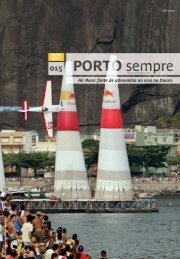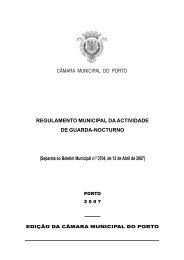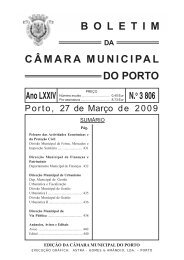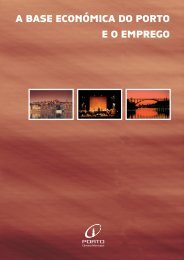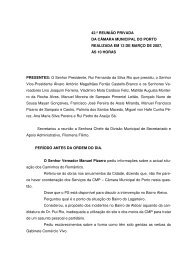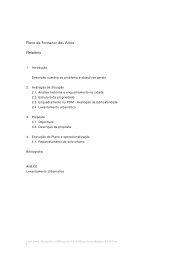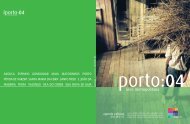01.CondAmb [020-031] [INGLæS] - Câmara Municipal do Porto
01.CondAmb [020-031] [INGLæS] - Câmara Municipal do Porto
01.CondAmb [020-031] [INGLæS] - Câmara Municipal do Porto
- No tags were found...
Create successful ePaper yourself
Turn your PDF publications into a flip-book with our unique Google optimized e-Paper software.
MSUQL1. Interpretation of the indicators and summary tables
Environmental conditions
MSUQL. ENVIRONMENTAL CONDITIONS.In addition to parks and gardens, streets with trees are also an asset in environmental and landscape terms,and contribute to the green structure of the city.<strong>Porto</strong> has a total length of streets with trees of approximately 86Km, that is, only 16% of all streets are atpresent lined with trees.As regards the spatial distribution of green spaces, there is a significant internal differentiation, with a greaterconcentration of parks, gardens and streets with trees in the West Side of the city.STREETS WITH TREES (2002)STREETS WITH TREESHISTORIC CENTRETRADITIONAL CENTRESOURCE: CMP/DMASUWEST SIDEEAST SIDE23
MSUQL. ENVIRONMENTAL CONDITIONS.AVERAGE HOURS OF SUNLIGHT PER DAYSOURCE: INSTITUTO GEOFÍSICO(no. of hours)1614121086420Jan.2001Feb.2001Mar.2001Apr.2001May2001Jun.2001Jul.2001Aug.2001Sep.2001Oct.2001Nov.2001Dec.2001Jan.2002Feb.2002Mar.2002Apr.2002May.2002Jun.2002Jul.2002Aug.2002Sep.2002Oct.2002Nov.2002Dec.2002AVERAGE HOURS OF ACTUAL SUNLIGHT PER DAYAVERAGE HOURS OF POTENCIAL SUNLIGHT PER DAYContrary to the effects of rainfall, a high average of hours of sunlight has a positive impact on the quality oflife of a city and of its citizens, since it allows for a vast choice of out<strong>do</strong>or activities, thus contributing to thepsychological welfare of people.When analysing the average hours of sunlight recorded in each month in 2001 and 2002, we find that thehigher values occur, as expected, in the spring and in the summer. In the analysed series, the maximum valueswere recorded in June 2001 (10.36h) and July 2002 (10.12h). These values are much higher than the annualaverage, which was 6.8h in 2001 and 6.5h in 2002.Notwithstanding, and having the relative insolation as reference, that is, the relation between the numberof hours of actual insolation and the average number of hours of sunlight possible, we notice that the city of<strong>Porto</strong> had an annual average of about 50%, a reality that is in alignment with the occurrence of a considerablenumber of days of rainfall.Urban Audit I comparative data:Average hours of sunlight per day– 1996Average: 5.4Minimum: 3.7 (Cork)Maximum: 7.9 (Seville)<strong>Porto</strong>: 6.6Number of city cases: 50The calculation of the indicatoris based on the insolationrecords, that is, the minutes ofdirect exposure to the sun arecounted and the daily average isthus calculated.25
NoiseMSUQL. ENVIRONMENTAL CONDITIONS.SELECTED INDICATORS• Noise exposureINTERPRETATION OF THE SUBJECTIssues concerning environmental noise, mainly in urban centres, havebeen increasingly regarded as extremely important by local agents, sincethe people’s growing exposure to high noise levels contribute negatively totheir Quality of Life, and may even become a public health hazard.At the present time, there isinsufficient basic information, asituation that will be solved soonsince the <strong>Porto</strong> City Council hasstart measuring noise levels toproduce a Noise Map.Noise exposure is a key indicator to evaluate the Quality of Life of acity, since it shows the percentage of the population that is affected by certain noise levels.The main noise sources in urban centres are road, rail and air traffic and industry.In the case of <strong>Porto</strong>, road traffic is extremely important not only due to its great density but also to theexistence of great roads within the city, which gives rise to high speeds and high volumes of traffic.Consequently, it is imperative to try to measure not only the noise levels in the main streets of the city butalso to quantify the resident population who is exposed to these levels of noise, as a way of establishingintervention strategies to improve the Quality of Life of citizens.26
Air qualityMSUQL. ENVIRONMENTAL CONDITIONS.SELECTED INDICATORS• Days with a Good or Very Good Air Quality IndexINTERPRETATION OF THE SUBJECTHigh indexes of atmospheric pollutants resulting from humanactivities have negative implications in the Quality of Life and in the healthof citizens. Nowadays, air quality issues are one of the mainenvironmental concerns, especially in the city centres of major cities wherepollution reaches worrying levels.The effects of atmospheric pollutants on the terrestrial Ecosystem aremultiple and can be felt at local and global scale.Although some of the chemical compounds that are considered pollutants nowadays could be found innature all along, the increase in their concentration and/or the capacity to combine in the atmosphere makethem toxic.In the case of <strong>Porto</strong>, car traffic is the main responsible for the major emissions of atmospheric pollutants.However, climatic conditions <strong>do</strong> not favour gas dispersion, thus leading to a high concentration of pollutants.The evolution of Air Quality in the city of <strong>Porto</strong> is not easy to analyse because the network of records andthe measured parameters have been through some changes in the past few years. Another aspect to take intoconsideration is the location of some measurement stations, which <strong>do</strong> not satisfy all the required criteria, thusinfluencing the quality of the data obtained.In 2002 <strong>Porto</strong> had a network of four measurement stations: Antas, Boavista, Rua <strong>do</strong>s Bragas and RuaFormosa, which contributed to the calculation of the index for the city.The indicator measures the percentage of days in which the Air Quality Index for the city of <strong>Porto</strong> was Goo<strong>do</strong>r Very Good, in the total number of records.The analysis of the data from the Air Quality Index for the city of <strong>Porto</strong> in 2002 shows a high monthlychange, with values fluctuating between 6% and 37% of days with a Good or Very Good Index.Such data has to be analysed carefully since the global index for each station and, consequently, for the cityof <strong>Porto</strong>, is influenced by the worst partial index of each pollutant. Normally, PM10 particles are the pollutantsthat are mainly responsible for indexes below Good.The calculation of the indicatoris based on the Air Quality Index(AQI) made available every dayby the Instituto <strong>do</strong> Ambiente(Environment Institute) andwhich is obtained from theaverage concentration values ofthe following pollutants: nitrogendioxide (NO2), sulphur dioxide(SO2), ozone (O3), carbonmonoxide (CO) and inhalableparticles (PM10).DAYS WITH A GOOD OR VERY GOOD AIR QUALITY INDEX (AirQI)SOURCE: INSTITUTO DO AMBIENTE(%)4035302520151050Jan.2002 Feb.2002 Mar.2002 Apr.2002 May.2002 Jun.2002 Jul.2002 Aug.2002 Sep.2002 Oct.2002 Nov.2002 Dec.200227
Basic infrastructureMSUQL. ENVIRONMENTAL CONDITIONS.SELECTED INDICATORS•Treated wastewater• Recoverable municipal solid wasteINTERPRETATION OF THE SUBJECTThe existence of a complete and efficient network of basic infrastructure,from water supply to wastewater treatment and to the recoveryof municipal solid waste, is essential to the Quality of Life of a city, both forthe welfare of the population and for environmental reasons.Wastewater treatment is essential in environmental terms since it triesto solve the problem caused by discharges into water courses and the sea, which therefore become morepolluted.The situation has direct negative impact on the environment and on the Quality of Life of a coastal city,depriving the population of these natural spaces.In the city of <strong>Porto</strong>, and during the period under analysis, there was a tendency for a gradual increase in thepercentage of treated wastewaters. In 2000 (with the opening of the Freixo Wastewater Treatment Plant) only9.3% of the wastewater was treated, whereas in 2002 the percentage increased to 20.8%.At the present moment, the wastewater treatment system is ensured by two Wastewater Treatment Plants.The Freixo WWTP opened in August 2000 and the Sobreiras WWTP in February 2003, together covering thewhole of the city. In the first semester of 2003, 34.5% of the wastewater was treated, but in some months thepercentage was higher than 50%.Another decisive environmental aspect in today’s society concerns the municipal solid waste production andtreatment conditions, since higher production levels require proper treatment of the waste.Traditional solutions such as landfill and composting have been aban<strong>do</strong>ned in favour of separate collectionand resources valorisation, which are unquestionably necessary for the sustainability of a city or region andcontribute to the preservation of natural resources, to the saving of raw material and energy and to thereduction in pollution.This indicator is an estimate ofthe percentage of wastewaterthat is treated in WastewaterTreatment Plants and is calculatedbased on the totalvolume of water billed by SMAS(Water and Sanitation <strong>Municipal</strong>Services) and on the volume ofwater that enters the WWTP tobe treated. It is estimated thatonly 80% of the billed waterenters the sanitation system.TREATED WASTEWATERSOURCE: SMAS PORTO(Thousands of m 3 )14,00012,00010,0008,0006,0004,0002,00002nd S.2000 1st S.2001 2nd S.2001 1st S.2002 2nd S.2002 1st S.2003WASTEWATERTREATED WASTEWATER29
MSUQL. ENVIRONMENTAL CONDITIONS.The Recoverable <strong>Municipal</strong> SolidWaste indicator or RecoveryIndex shows the relation betweenthe totality of the materialcollected separately (in recyclingbins and collective equipment),which is potentially recoverable,and the totality of the <strong>Municipal</strong>Solid Waste. All separatelycollected waste was taken intoaccount: paper/board, glass,metal, green waste and plastics/packaging.SOURCE: CMP-DMASUMUNICIPAL SOLID WASTE PRODUCED IN PORTO (kg per capita)1999 2000 2001 2002Recoverable MSW 27.5 45.0 47.7 38.1Undifferentiated MSW 640.2 631.5 634.4 621.6Total MSW 667.7 676.5 682.1 659.7RECOVERABLE MUNICIPAL SOLID WASTE(%)87SOURCE: CMP-DMASU65432101999 2000 2001 2002Urban Audit I comparative data:Urban Solid waste recycled (%) –1996.Average: 12.5Minimum: 0.2 (Naples)Maximum: 62 (Brussels)Number of city cases: 38The production of municipal solid waste (MSW), from undifferentiated or separate collection has increasedin the past few years, with the exception of 2002.The MSW ratio in the city of <strong>Porto</strong> is still higher than the average of around 550 Kg per capita in 1999 for theEuropean cities (Eurostat).In regards to the separate collection of waste, and according to the recent evolution, the trend is for anincrease, although gradual, making citizens more willing to cooperate in this effort.Nevertheless, the proportion of waste collected separately is still low, having stayed below 7% in the yearsunder consideration, which, compared with the average for European cities, is manifestly inferior.As for the type of material that is disposed separately for recycling or recovery, glass and paper/board havegreat weight thanks to a bigger network of disposal points, as well as green waste, that is, vegetable materialresulting from the maintenance of green spaces (public and private).RECOVERABLE SOLID WASTESOURCE: CMP-DMASU200220012000PACKAGINGWOOD WASTEPAPER/BOARDMETALGREEN WASTEGLASS19990% 10% 20% 30% 40% 50% 60% 70% 80% 90% 100%30
MSUQL. ENVIRONMENTAL CONDITIONS.Summary tableGREEN SPACESINDICATORS UNITS LAST VALUE/YEAR TENDENCY/PERIOD QOL SITUATIONPublic green spaces per capita m 2 /inhab. 7 2002 – – Streets with trees km 86 2002 – – CLIMATEDays of rainfall % 50.0 2002 – – ☹Average hours of sunlight per day hours 6.5 2002 – – NOISENoise exposure – – – – – –AIR QUALITYDays with a Good or Very Good Air Quality Index % 17.5 2002 2002 ☹BATHING WATER QUALITYRecords of Good bathing water quality % 50.0 2002 2001/2002 ☹BASIC INFRASTRUCTURETreated wastewater % 20.8 2002 2000/2002 ☹Recoverable municipal solid waste % 6.2 2002 1999/2002 ☹Evolutionary tendency of the indicator:Growth with a positive impact on the QOLReduction with a positive impact on the QOLStabilityGrowth with a negative impact on the QOLReduction with a negative impact on the QOLEvaluation of the present situation in terms of Quality of Life:☺ Good Reasonable☹ Bad31


![01.CondAmb [020-031] [INGLæS] - Câmara Municipal do Porto](https://img.yumpu.com/48647213/1/500x640/01condamb-020-031-inglas-camara-municipal-do-porto.jpg)
![2. Mater. Colect. [42-59] - Câmara Municipal do Porto](https://img.yumpu.com/51414906/1/184x260/2-mater-colect-42-59-camara-municipal-do-porto.jpg?quality=85)
